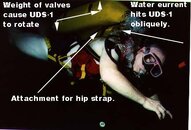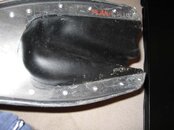Revan, you are correct, in that the finswimmers do not help finding this for recreational divers. But I wanted to show the outside limit on swimming speed. Your look at underwater orienteering was a great example too. Not too many people know that in Europe, Asia and other areas of the world these games are very competitive. Underwater hockey is popular in pools in Canada, as they cannot get into the water much in the winter. Here are the finswimming records from CMAS (the World Underwater Federation).
Records
The World Record for 800 meters immersion looks like this:
800 05:46.96 VILHELM Szilard 1983 HUN 28/07/2010 KAZAN
That (05:46.96 for 800 meters) is probably the outside limit for humans for a cruising speed.
Before talking about the Hammerhead Unit, I'd like to spend a few minutes on swim fin design. I started experimenting with a different type of blade in the 1960s. I was convinced that the flat blade that we used then, and actually still use today, was not the most efficient way to move a diver through the water, independent of the type of kick used. I developed what I now call the "scoop fin" design. With the scoop fin, which anyone can duplicate, I removed the flat blade, and replaced it with a tapering flexible membrane. Several years later, when I was looking to patent the concept (it was already patented, by Mucdock, Patent #3,411,165), I made this analysis:
I converted a pair of AMF Voit A66 fins to the scoop design and made these photographs of how the water flows on the fin:
Note that the water flows down the blade, and out. It doesn't roll off the edges like with normal flat blades.
Freediving fins have a longer, flat blade, and work differently, using a rolling motion to ensure that the water flows back. But even today's "channel" fins do not duplicate what I did years ago, and continue to use today. You can see some of my more recent blade modifications below.
I have also enclosed an Excel spreadsheet with three headings. The Fin trails 3-12-2010 were conducted using identical fins, except one was the blade, one was modified to be a split fin design, and one was modified to be a scoop design. You can see these fins below.
The second heading wis "Fin Trails 3-13-2010" and included the Quattro Excel, Jet Fin, White Stage Super Stag, and that Super Stag fin modified to be a scoop design, the Jet Fin & Jet Split Fin combined (I found that fin in the river, with a spring heel that had caught on a rock and the spring was then about 3 feet long after being subjected to the river's floods over a winter), USD Rocket fins, and the Apollo Split Fins (full-foot variety).
The final tests were using the full-foot PlanaPlus fins, which were the same fin modified twice (split and scoop). Take a look, as I would be interested in your feedback.
SeaRat



















